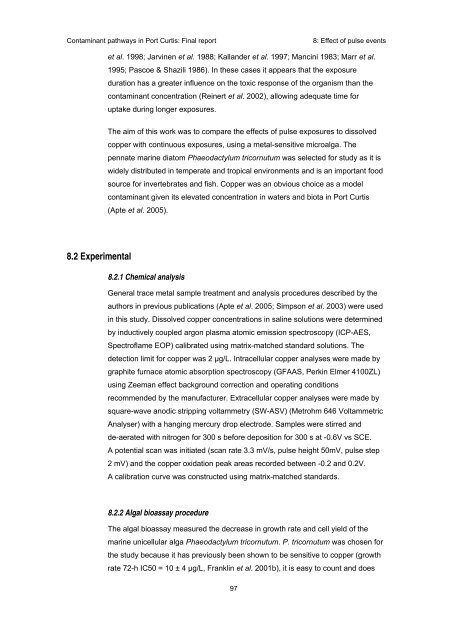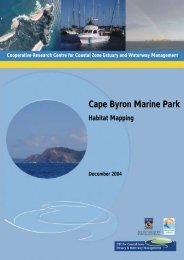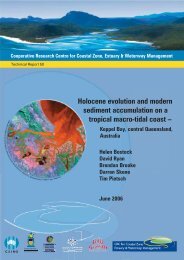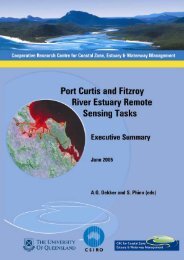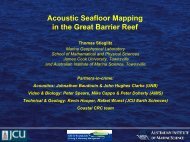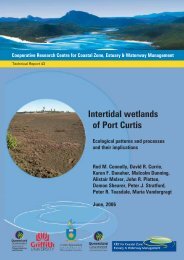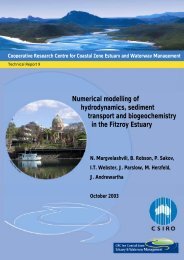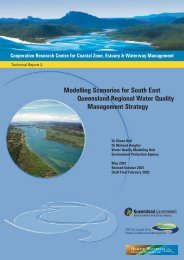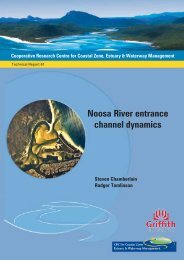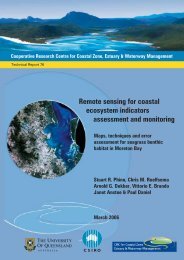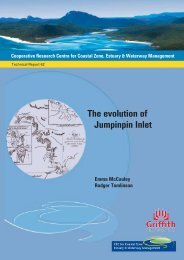Contaminant pathways in Port Curtis: Final report - OzCoasts
Contaminant pathways in Port Curtis: Final report - OzCoasts
Contaminant pathways in Port Curtis: Final report - OzCoasts
You also want an ePaper? Increase the reach of your titles
YUMPU automatically turns print PDFs into web optimized ePapers that Google loves.
<strong>Contam<strong>in</strong>ant</strong> <strong>pathways</strong> <strong>in</strong> <strong>Port</strong> <strong>Curtis</strong>: F<strong>in</strong>al <strong>report</strong>8: Effect of pulse eventset al. 1998; Jarv<strong>in</strong>en et al. 1988; Kallander et al. 1997; Manc<strong>in</strong>i 1983; Marr et al.1995; Pascoe & Shazili 1986). In these cases it appears that the exposureduration has a greater <strong>in</strong>fluence on the toxic response of the organism than thecontam<strong>in</strong>ant concentration (Re<strong>in</strong>ert et al. 2002), allow<strong>in</strong>g adequate time foruptake dur<strong>in</strong>g longer exposures.The aim of this work was to compare the effects of pulse exposures to dissolvedcopper with cont<strong>in</strong>uous exposures, us<strong>in</strong>g a metal-sensitive microalga. Thepennate mar<strong>in</strong>e diatom Phaeodactylum tricornutum was selected for study as it iswidely distributed <strong>in</strong> temperate and tropical environments and is an important foodsource for <strong>in</strong>vertebrates and fish. Copper was an obvious choice as a modelcontam<strong>in</strong>ant given its elevated concentration <strong>in</strong> waters and biota <strong>in</strong> <strong>Port</strong> <strong>Curtis</strong>(Apte et al. 2005).8.2 Experimental8.2.1 Chemical analysisGeneral trace metal sample treatment and analysis procedures described by theauthors <strong>in</strong> previous publications (Apte et al. 2005; Simpson et al. 2003) were used<strong>in</strong> this study. Dissolved copper concentrations <strong>in</strong> sal<strong>in</strong>e solutions were determ<strong>in</strong>edby <strong>in</strong>ductively coupled argon plasma atomic emission spectroscopy (ICP-AES,Spectroflame EOP) calibrated us<strong>in</strong>g matrix-matched standard solutions. Thedetection limit for copper was 2 µg/L. Intracellular copper analyses were made bygraphite furnace atomic absorption spectroscopy (GFAAS, Perk<strong>in</strong> Elmer 4100ZL)us<strong>in</strong>g Zeeman effect background correction and operat<strong>in</strong>g conditionsrecommended by the manufacturer. Extracellular copper analyses were made bysquare-wave anodic stripp<strong>in</strong>g voltammetry (SW-ASV) (Metrohm 646 VoltammetricAnalyser) with a hang<strong>in</strong>g mercury drop electrode. Samples were stirred andde-aerated with nitrogen for 300 s before deposition for 300 s at -0.6V vs SCE.A potential scan was <strong>in</strong>itiated (scan rate 3.3 mV/s, pulse height 50mV, pulse step2 mV) and the copper oxidation peak areas recorded between -0.2 and 0.2V.A calibration curve was constructed us<strong>in</strong>g matrix-matched standards.8.2.2 Algal bioassay procedureThe algal bioassay measured the decrease <strong>in</strong> growth rate and cell yield of themar<strong>in</strong>e unicellular alga Phaeodactylum tricornutum. P. tricornutum was chosen forthe study because it has previously been shown to be sensitive to copper (growthrate 72-h IC50 = 10 ± 4 µg/L, Frankl<strong>in</strong> et al. 2001b), it is easy to count and does97


